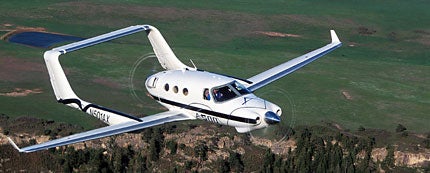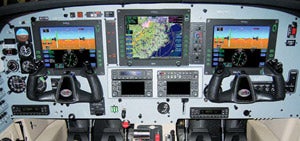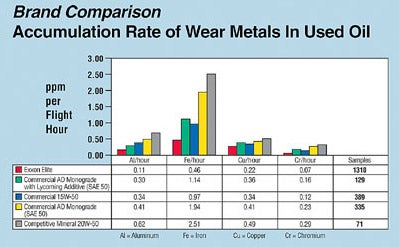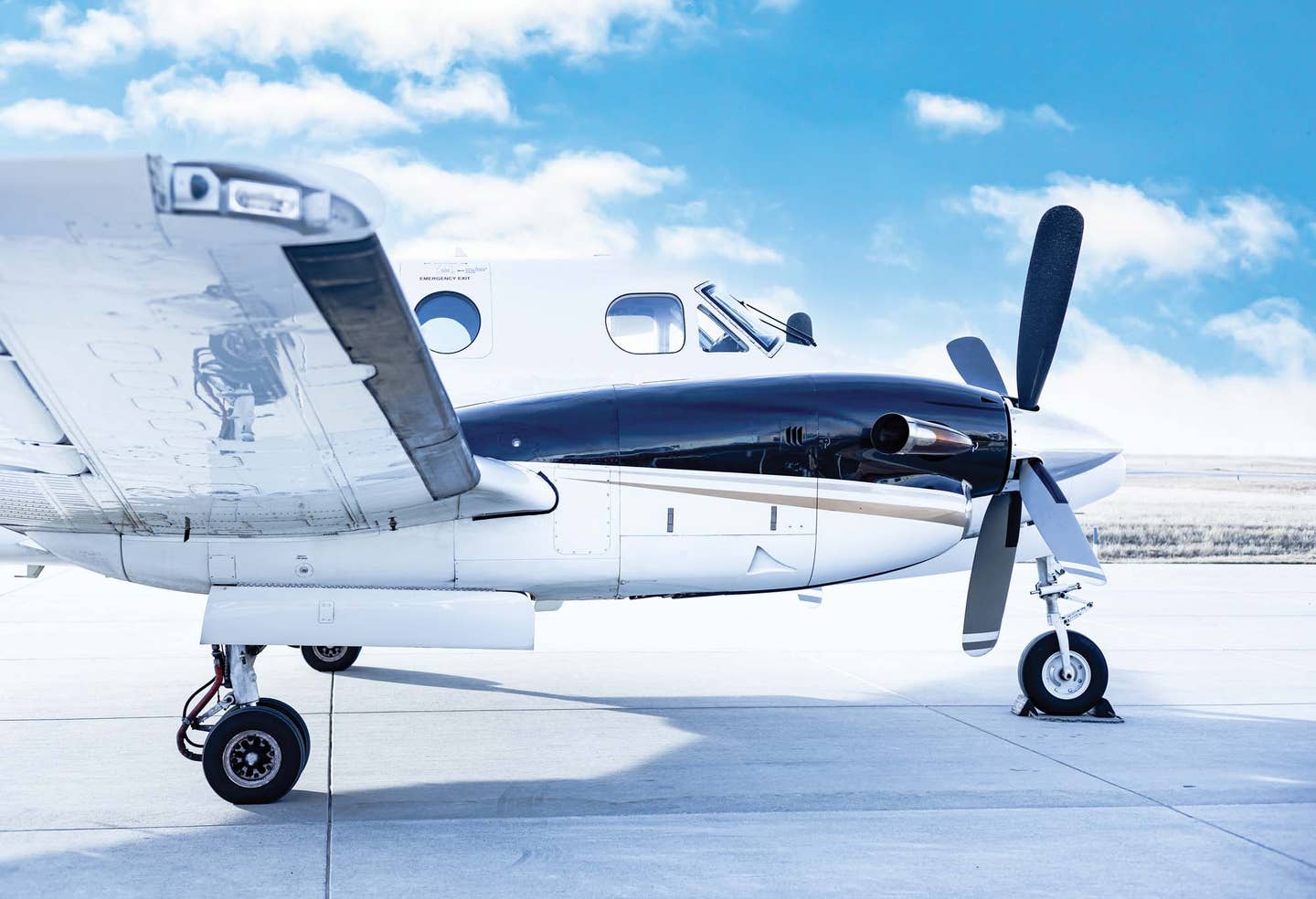July-Aug 2005 On The Radar
Adam Aircraft received the final type certificate for the pressurized, twin-engine A500. Less than one year after founders Rick Adam and John Knudsen gave Burt Rutan $1 million and a back-of-the-napkin design for an all-composite, centerline-thrust twin, a proof-of-concept A500 was flying over Mojave, Calif. In 2002, flight testing began out of Denver’s Centennial Airport.
 Attaboy, Adam!
Attaboy, Adam!
Adam Aircraft received the final type certificate for the pressurized, twin-engine A500. Less than one year after founders Rick Adam and John Knudsen gave Burt Rutan $1 million and a back-of-the-napkin design for an all-composite, centerline-thrust twin, a proof-of-concept A500 was flying over Mojave, Calif. In 2002, flight testing began out of Denver's Centennial Airport. Production of the A500 will continue in Colorado and now in Ogden, Utah, to meet the company's goal of producing six aircraft a month. Adam estimated its design team has spent more than 1.5 million man-hours since certification operations began in 1998.
 Final performance numbers for the A500 include a 230-knot cruise speed, 1,000-plus nm NBAA IFR range at 75% power and a cabin altitude of 8,000 feet at its maximum altitude of 25,000 feet. The A500 is expected to compete head-to-head against the Beechcraft Baron and even the King Air, both of which leave the door with a heftier price tag. Customer deliveries of the A500 are expected to begin in Q3 of this year. Adam Aircraft continues flight testing for its pure jet A700. For more information, contact Adam Aircraft at (303) 406-5900 or log on to www.adamaircraft.com.
Final performance numbers for the A500 include a 230-knot cruise speed, 1,000-plus nm NBAA IFR range at 75% power and a cabin altitude of 8,000 feet at its maximum altitude of 25,000 feet. The A500 is expected to compete head-to-head against the Beechcraft Baron and even the King Air, both of which leave the door with a heftier price tag. Customer deliveries of the A500 are expected to begin in Q3 of this year. Adam Aircraft continues flight testing for its pure jet A700. For more information, contact Adam Aircraft at (303) 406-5900 or log on to www.adamaircraft.com.
 The World's Most Popular Airplane Goes Glass
The World's Most Popular Airplane Goes Glass
Aliens returning from a visit to Earth would report that the most commonly occurring aircraft on the planet is the Cessna 172. Since its release in 1956, production numbers are approaching the 50,000 mark. Eat your heart out, Boeing. Now the venerable Skyhawk is available with a full glass cockpit, making the world's most popular airplane also one of the most capable.
The Garmin G1000 integrates all primary flight, engine and sensor data to provide at-a-glance situational awareness. Real-time, flight-critical information is presented on two big, colorful 10.4-inch active-matrix LCD screens. This optional Nav III package is available on both the 172R-GA and 172S models. For more information, call Cessna Aircraft Company at (800) 4-CESSNA or visit www.cessna.com.
 |
| Evektor SportStar |
 |
| Flight Design CT |
 |
| Cessna Mustang |
 |
| Eclipse 500 jets |
 |
| Avidyne Entegra on the Symphony 160 |
LSAs are Here!
On April 8, 2005, at ceremonies in Lakeland, Fla., the Federal Aviation Administration (FAA) awarded special light-sport aircraft (S-LSA) certification to the Evektor SportStar and the Flight Design CT. Both aircraft are imports from overseas. Over the next few months, as many as a dozen other aircraft are expected to apply for similar certification, including the IndUS Aviation Thorp (www.indusav.com), the Legend Cub (www.legendaircraft.net), the Zenair CH601 (www.senair.com), the Rans Coyote (www.rans.com) and the KP-5 imported by Kappa Aircraft (www.ultralight.cz).
The FAA published the sport-pilot and light-sport aircraft rules in September 2004, but it has taken the last seven months for the details of regulations to be ironed out. The approval of the fourth and final segment of the light-sport aircraft regulations came in late March 2005, and the first aircraft certifications came just more than a week later at the Sun 'n Fun Fly-In (www.sun-n-fun.org).
Last year's FAA publication created two new aircraft airworthiness certificates: one for S-LSA, which may be used for personal as well as for compensation while conducting flight training, rental or towing; and a separate certificate for experimental light-sport aircraft (E-LSA), which may be used only for personal use. The rule also establishes requirements for maintenance, inspections, pilot training and certification. The two new S-LSA certifications are important because these aircraft now can be used for flight training for the new sport-pilot license. For more info, click on the FAA's Website at www.faa.gov.
 |
| Symphony 160 |
 |
| New Piper Meridian |
And Now The VLJs
The race to certification for the very light jet (VLJ) category is still a little too close to class, but once-front-runner Eclipse Aviation is again claiming the lead. The Albuquerque, N.M.-based manufacturer now has three Eclipse 500 jets in flight testing and is predicting certification in early 2006. Now flying with Pratt & Whitney PW610F turbofans, Eclipse reports its pace has accelerated and is, once again, on track to be the first to deliver. For more info, contact Eclipse Aviation at (505) 245-7555 or check out www.eclipseaviation.com.
Cessna's VLJ entry, the Mustang, already has entered flight testing and anticipates using three airframes for the certification process. Cessna announced this smallest member to its Citation family in 2002 with a projected certification in 2006. The Mustang is projected to have a 1,300-nm IFR range and a full-fuel payload of 600 pounds (not counting a single pilot), with a ceiling of 41,000 feet.
 The Mustang and the Eclipse 500 generally are considered to be the front-runners for a first-place finish as the first VLJ, although as we all know, anything can happen. As well in the pack are the Adam A700, the ATG Javelin (www.avtechgroup.com), the Diamond D-JET (www.diamondair.com) and the Sino Swearingen SJ30-2 (www.sj30jet.com). The Vantage Jet has popped up in Brazil, hoping to finish its flight testing there and take advantage of Brazilian and FAA certification reciprocity. Rumors of other jet development projects at Piper (www.newpiper.com), Cirrus (www.cirrusdesign.com), Epic (www.epicaircraft.com) and others are widespread.
The Mustang and the Eclipse 500 generally are considered to be the front-runners for a first-place finish as the first VLJ, although as we all know, anything can happen. As well in the pack are the Adam A700, the ATG Javelin (www.avtechgroup.com), the Diamond D-JET (www.diamondair.com) and the Sino Swearingen SJ30-2 (www.sj30jet.com). The Vantage Jet has popped up in Brazil, hoping to finish its flight testing there and take advantage of Brazilian and FAA certification reciprocity. Rumors of other jet development projects at Piper (www.newpiper.com), Cirrus (www.cirrusdesign.com), Epic (www.epicaircraft.com) and others are widespread.
The Glass Menagerie
The battle of the VLJs isn't the only conflict that is brewing in aviation. There's a war going on between the two prime general-aviation glass-cockpit manufacturers, Garmin and Avidyne, for your panel. The latest battle goes to Avidyne.
Symphony Aircraft (www.symphonyaircraft.com) and New Piper (www.newpiper.com) both endorsed the Avidyne FlightMax Entegra. The Symphony 160 becomes the first two-seat aircraft to offer glass-cockpit technology. Starting this month, the PA-46 turbine Meridian joins the Piper family of PA-28s (Warrior, Archer and Arrow) and the PA-32s (Saratoga and 6X) with an integrated big-screen flight deck.
Avidyne (www.avidyne.com) also announced a series of new features for the Entegra. Lancair Columbia 350s and 400s will become the first aircraft to offer MultiLink. This technology integrates Avidyne's existing Narrowcast Datalink weather system with XM WX broadband satellite downloads for weather info across the continental United States. XM WX provides high-speed, nearly real-time, NEXRAD radar images along with METARs, AIRMETs, SIGMETs, TFRs and lightning strike data. Datalinking services also are available to Avidyne customers on the ground via FlightCenter services. Users on the Internet can track aircraft en route as well as send two-way text messages back and forth to the cockpit.
The Avidyne Entegra also now has radar display capabilities, allowing data from the Honeywell Bendix/King RDR2000 digital radar to overlay onto the EX500's 10.4-inch flat screen. Pilots can toggle back and forth between airborne radar and NEXRAD radar images for double-whammy weather viewing.
Recently, Avidyne announced a flight director for the Cirrus SR20 and SR22, as well as CMAX digital charts and approach plates. The FAA now says that electronic chart displays relieve any regulations for carrying paper backups in the cockpit, although many pilots say they will keep a set of old-fashioned paper on board---just in case. But stay tuned---Garmin is expected to announce upgrades to the G1000 glass panel this month at the EAA AirVenture. Call Avidyne at (800) 284-3963 or visit www.avidyne.com, or call Garmin at (913) 397-8200 or log on to www.garmin.com for more info.
 Exxon Causes You To Wear Less?
Exxon Causes You To Wear Less?
ExxonMobil Aviation Lubricants are reporting what they call "significant research analysis" that indicates aircraft engines lubricated with Exxon Aviation Oil Elite 20W-50 wear less (see the Brand Comparison chart). The company gathered data from an independent laboratory that performs oil analysis to determine the amount of metal, reported as parts per million, that ended up in the oil. According to Exxon, results of oil analyses from 1998 through 2004 show a 33% to 50% decrease in the presence of wear metals in engines lubricated with Elite.
"The results are verifiable for any other company to analyze," says Exxon/Mobil's Steve Sunseri. "We have 99% confidence in the results, which means that if this test was done 100 times, one in 100 might come up with a different result." Exxon commissioned the study after customers reported a decrease in wear metals. Contact Exxon/Mobil at (800) 662-4525 or click on www.exxonmobil.com.

Subscribe to Our Newsletter
Get the latest Plane & Pilot Magazine stories delivered directly to your inbox






